I’m hoping to hit the road in April and report to you from someplace other than this moldy office.
OK, it’s not moldy, and the asbestos was removed years ago. But winter, even Washington’s tame one, has that effect on you. Fortunately the fruit-and-vegetable vendor returned to his spot across the street this morning – an even more reliable sign of spring than a robin’s call or Carol’s reminder that the porch needs washing, the pansies need planting, and the sills need dusting.
. . . which are all good reasons to hit the road.
In the meantime, I keep shaking my head about what’s happening to a great American institution: the daily newspaper.
Things have gone from bad to worse – or as cable-TV commentator Keith Olbermann would say, worse to worser – since I last lamented newspapers’ fate.
And worstest may not be far away.
 |
| This newspaper’s new online-only staff, which is one-eighth the size of the former newspaper staff, won’t need this big a building any longer |
Already this month, the 146-year-old Seattle Post-Intelligencer switched off its presses for good, replacing a 165-person news staff with 20 who will put out an online edition. And just 55 days shy of its 150th anniversary in the newspaper business, the Rocky Mountain News closed its doors entirely. Those two developments left Seattle, Washington, and Denver, Colorado, as America’s latest one-daily towns.
And there’s much more news in the world of print journalism – none of it good.
 |
| Things are dire – though maybe not yet this dire – for many newspaper employees across the country as their papers struggle to survive |
Philadelphia Newspapers, L.L.C., which owns the venerable daily Inquirer broadsheet as well as the tabloid Daily News, and which is staggering under a $390-million debt load, filed for bankruptcy protection. And the Tribune Company, one of the nation’s most prestigious newspaper outfits as the owner of the Chicago Tribune and the Los Angeles Times, filed for bankruptcy as well, hoping to try to find a way out from under $13 billion of debt. Count the Minneapolis Star-Tribune among the bankruptcy filers, too. The publicly traded New York Times has suspended stockholder dividends. The Gannett Co. is requiring its employees at the national USA Today daily newspaper to take a week’s furlough without pay as a bitter alternative to losing their jobs entirely.
I’ve already told you, in an earlier blog, about the travails of Detroit’s struggling dailies. Their story is nearly replicated by the acclaimed national daily The Christian Science Monitor, which will soon go online only, save for weekend and some special-occasion print editions.
And the Washington Post has eliminated its separate, award-winning Business and Book World sections, folding some – just some – of their contents into other parts of the paper. These were, the paper’s ombudsman, Andrew Alexander wrote, “wrenching decisions” by a “money-losing newspaper, mired in a bad economy.”
The Washington Post, once thought to be a “license to print money,” now a money-losing newspaper? Why, the U.S. stock market would have to lose half its value before such a thing happened.
Oh, sorry.
 |
| This is pretend strangling. The constriction of American newspapers is for real |
All of this to try to stanch the terrible bleeding in daily newspaper revenues. It would take several blogs to cover the smaller weekly papers that are in desperation mode.
Buy-outs of the contracts of senior reporters and editors, elimination of costly national and international bureaus, and other cost-cutting measures can do only so much when readership and advertising levels are nosediving. Only mortgage bankers and car dealers have had a worse – worser? – month.
Sad times for the reporters and clerks and print shop grunts at newspapers. And for those who love their product. As Gregory E. Favre, a former top Chicago newspaper editor, wrote on the Poynter Institute’s Web site, “There is no easy way to say goodbye to the newspaper you love. . . . And worst of all is when the death comes quickly. When we don’t have time to prepare our thoughts, to really share last conversations and memories, to make sure the past is honored.”
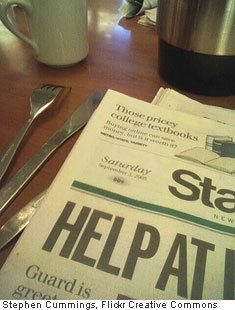 |
| Reading the paper is a morning tradition that ranks alongside brushing one’s teeth. Note the apt first word in this A.M. newspaper headline: “HELP” ! |
This matters to the fabric of American life, if only to a shrinking generation of mainly older diehards who treasure the ritual of retrieving the paper from the front lawn, unfolding it with a flourish over coffee and juice or more circumspectly on the subway or bus, and reading their favorite columnists and the stories that the papers’ news editors have selected for their attention.
But others have elbowed the oldsters aside:
One is a cadre of young people, in the main, who don’t read newspapers – or much of anything in print. They believe there’s just no time, what with all the appetizing choices available on their computers and hand-held texting devices. They see
 |
| Who has time to read the newspaper with so many other communication alternatives available? |
newspapers as cumbersome, dense with useless information, hopelessly behind the latest developments, and unconnected to their lives. It is, after all, their lives that matter, not what’s happening to anyone else. They want to read what they want to read, not what some “gatekeeper” editor puts in front of them.
 |
| With more and more newspapers and online news available for free and thought to be eminently discardable, getting people to pay for the daily paper is an ever-harder sell |
The second cadre is somewhere in the middle. Many of them still glance at the paper in the morning or read the free, advertising-laden handout papers before leaving them behind on the seat or floor of the train. They browse a bit longer through the fatter newspaper on Sundays, when time is more their own. But they rarely dig into long stories or explore sections of the paper that normally don’t interest them. And according to surveys and their own accounts, they pay little if any attention to the ads that support the enormous amount of money that’s required for a publisher to mount a credible newsgathering effort. These occasional, cursory, and casual readers, too, spend a whole lot more time checking various Web sites online.
It didn’t take long for advertisers to pick up on this, of course. They’re drastically downshifting their investment in the daily paper or moving their dollars entirely elsewhere. This can spell, and has spelled, doom to many a once-proud paper.
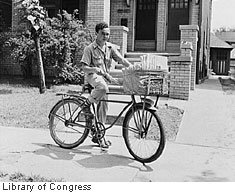 |
| Take a good look at this young newspaper carrier. He’s part of what looks like a dying breed |
Readership groups Two and Three – the halfhearted ones and those that never pick up a paper at all – say it’s no skin off their noses. If the paper disappears entirely, there are plenty of other places to find news and information. Besides, they’ll save a few bucks that had gone to the newspaper delivery boy or girl, the street vendor, or the corner newsbox.
The problem for society, though, is that while wild-eyed opinion pieces fly back and forth in ever-greater numbers on the Web, and broadcast and online media will still chase the big breaking stories, who will have the staff and the finances – or the inclination – to do hard reporting legwork, investigate government and corporate misdeeds, probe the causes of seismic economic shifts? Who will have the institutional memory to dig into old crime stories or put together historical comparisons? Who will fund thoughtful cultural criticism, travel reporting, and in-depth sports coverage? Can a staff of 20 at the new, online P-I – the Post-Intelligencer – do all that?
Carol, who falls into the occasional-reader category, replies that she can find anything she wants online, and so can anyone. Chess puzzles, recipes, long stories about disgraced Ponzi schemer Bernard Madoff, right and left opinions of our new president’s performance in office, and on and on.
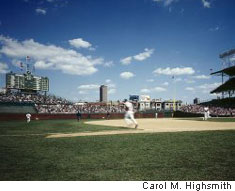 |
| I’d pay the modest newspaper subscription price just to read in-depth coverage of my favorite sports. Might even pay for such stories online if I had to |
Yes, but I contend that the mind cannot grow when one fills it with only the things it wants. I certainly do want to read about the latest twists and turns on Wall Street, details of last night’s Washington Capitals’ hockey game, and more information about a big plane crash from the day before. But even more, I also love to check out whatever the paper’s editors have chosen to lay before me.
Here are just five headlines from a single day’s newspaper the other day:
“A Silenced Drug Study Creates an Uproar.”
“Ringling Bros. [Circus] Hits Town as [Animal-Rights] Case Heats Up”
“Trade Barriers Could Threaten Global Economy”
“Selection Committee Doesn’t Want Cinderella at the [National College Basketball Tournament] Ball.”
And . . . “With Punch Lines Instead of Headlines, ‘Ted’s’ a Great – Well, Good – Escape.”
How could I not be interested in that last one? Turns out, “Ted” is part of the name of a new television show.
It’s true that Carol could probably have found similar material among the 800-gazillion Websites online. But how would she have found them? Would she give them more than a glance on her computer screen? How could she easily mark them up, clip them, or set them aside for later viewing?
 |
| Town criers are long gone, except on ceremonial occasions. Their modern-day equivalent of news messengers – the daily paper – is barely hanging on |
Kathleen Parker, a conservative columnist syndicated by the Washington Post Writers’ Group, posed it this way in a recent column: “How does the newspaper industry survive in a climate in which the public doesn’t know what it doesn’t know? Or what it needs?”
“As others have noted, the Internet can’t quickly enough fill the void created by lost newspapers,” she continued. “In time, some markets simply won’t have a town crier – and then who will go to all those town meetings where news is made? What will people not know [emphasis mine]? In such a vacuum, gossip rules the mob.”
 |
| News, news, read all about it… on your favorite video game? |
And here’s the worster of it: Parker adds that, gulp, news may soon be delivered by via video games.
(I wish I were kidding.)
Then, as she puts it, “forget blogs, tweets, and tags.”
In such a cultural abyss, newspapers would have already been long forgotten.
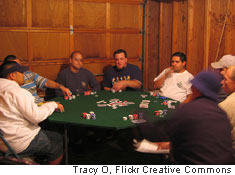 |
| It is possible to get a coherent idea, as well as chips, on the table at a poker game. This is not my group, I should point out. These guys are better looking |
One idea advanced in many newsrooms – and at my monthly poker game, where most players are journalists and one is a long-term Los Angeles Times correspondent – centers on those newspaper Web sites, which, as I have noted, are attracting more and more readers who say they’re too busy to sit down and read the print editions. “It was arguably a mistake [maybe a slowly fatal one] for newspapers and magazines to hand out their goodies to anyone with a computer screen” by launching Web sites that competed with themselves, the Post’s media writer, Howard Kurtz, wrote recently.
“[B]ut the culture of the Net was – and is – that everything should be free. The question now is whether that mind-set can be changed.”
The irony, as Time magazine has pointed out, is that newspapers have more readers than ever, counting those who glance at their Web sites. “The problem is that fewer of these consumers are paying. Instead, news organizations are merrily giving away their news.”
The misguided idea was to assign top writers, editors, and photographers to the papers’ Web sites in an effort to join the “Internet revolution,” perhaps make some money from online advertisements, and cross-promote the daily printed product.
The last of these efforts clearly has failed spectacularly.
So at my poker table and elsewhere where journalists gather and tremble, the talk has gone something like this:
 |
| Charge money for newspaper content on the “free” Internet? Many newspapers are scared to try |
“Yes, for sure, we should have charged for our content, even if it was just a little bit. But a little bit times thousands and thousands of readers would have added up and paid a lot of bills. So the only answer we can come up with is to somehow begin charging now. Readers won’t like it, since people are used to getting good content for free on the Web, but what other choice is there?”
Former Time magazine managing editor Walter Isaacson is one media luminary who supports what he calls “micropayments” for online newspaper content. Under his system, newspapers would put their very best work, by their top writers, online. Readers, in turn would pay a modest sum for articles that interest them, much as people buy their favorite sodas out of vending machines.
Presented with the idea of charging for online content, though, those at my poker table – especially after losing a pot or three and in a sour mood – lamented that the genie is out of the bottle and can’t be stuffed back in. They say the only way to begin charging for Internet content would be for every paper – news magazines, too – to do so. If people wanted well-researched, carefully edited original reporting and nonpartisan commentary, they’d have no choice but to pay for it.
Then, my pals would sigh, bitterly: “Of course, not everyone would agree to charge for their Web product. And so no one will.”
This was all especially interesting because the conversation, fixated on the future of news on the Web, seemed to concede that print journalism products were fated to financial strangulation and a slow death.
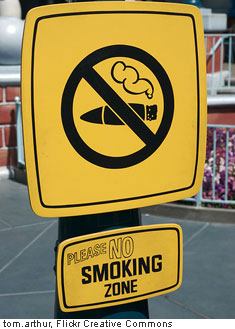 |
| Don’t let Carol see this sign |
Two days after my poker game, I was huddled near a space heater in my work shed, smoking a cigar and listening to a favorite local sports-talk show. Carol banishes me, or more correctly, the smoke, to the shed except on those monthly poker nights when it’s too cold to play on the porch. Then she tolerates the stench, rarely without comment and a not-so-furtive glance at the yellowing curtains.
To my surprise, the radio sports reporters – including Steve Czaban, who also hosts his own national morning sports-talk show, and Thom Loverro, who writes for the daily Washington Times here in town and knows firsthand the trouble that papers are in – got to talking about newspapers’ downward spiral. And Czaban came up with a rescue idea that was almost the exact opposite of conventional wisdom.
 |
| Steve Czaban, left, and Andy Pollin surprised me, and maybe others, with a provocative discussion about newspapers’ future, of all things, on their WTEM sports show in Washington, D.C. |
“Czabe,” as his devoted listeners call him, drew this analogy to what newspapers are doing right now: It’s as if a premier steakhouse had its chefs prepare bite-sized samples of its finest filets, sirloins, chops, and side dishes. Then waiters would put them on trays, carry them out to the street, and pass them out, for free. Passersby would, in fact, be encouraged to help themselves, on the theory that they’d love the food so much that they’d come right into the restaurant or make reservations for a full, paid meal.
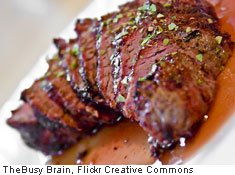 |
| Hey, here’s an idea for newspapers: Give away samples, like free slices of steak, in hopes of building readership. Oh, they’re already doing that on the Web |
That’s an absurd business plan, of course, Czaban continued, with clear logic. Most people would just help themselves to the samples, say thank you very much, and move right along. The place would get few new, paying customers and, in fact, would soon go broke distributing the free samples.
Sound familiar, news executives?
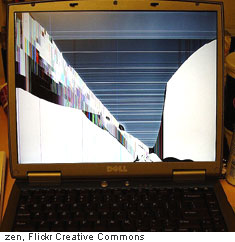 |
| Steve Czaban’s idea: Instead of scrounging for ways to get people to pay for newspaper content online, get out of the Internet business entirely |
Instead of charging Web readers for newspaper content, which they would likely resist and certainly resent, and instead of just giving the content away as they do now, Czaban suggested that papers shut down their Web sites entirely!
That would force anyone who wanted the content that only a local daily newspaper can consistently supply to return to the printed product!
Loverro, co-host Andy Pollin, and listeners mostly responded that this was a brilliant idea in theory but would not work for one of two reasons, or both: • Someone else would jump into the void and produce an information-rich local news-and-feature Web product or • in cities like Washington that have more than one daily, the paper that held onto its Web version would “wipe up” and gain the loyalty of thousands of readers who were mad at the paper that pulled its online edition. That, of course, would mean that the competing paper’s strategy of eliminating its Web product had backfired terribly.
Czaban replied to the first point – correctly I think – that there might be meager attempts at producing new local, online information products. But nobody besides a big publisher has the staff or other resources to come up with original stories, reported from the scene, or to pay top columnists and commentators. Web sites, including blogs like Ted Landphair’s America, rely heavily on – read: steal ideas from – the hard work of newspaper reporters. They’re not going to do this hard work themselves. So, Czaban said, newspapers might as well at least get sales from their printed editions before everybody else packages the information electronically, not give it away online themselves.
 |
| Online ads are nothing new to newspaper publishers, but they haven’t proven to match the income potential of the printed variety. Full-page ads would take the reader away from content, for instance |
The second objection – that papers that kept their Web sites as their competitors shut theirs would “wipe up” – is trickier. Even buying the idea that eliminating the Web site would be suicide against local competition, the paper that gained all the new Web readers would not necessarily be celebrating. Its online visitor numbers might skyrocket, but that wouldn’t bring a dime into the printed paper’s coffers. Or perhaps help the online site much either, since ads on newspaper Web sites have certainly not been cash cows. And so, if survival of the printed newspaper was the goal, both papers – the one that abandoned its Web site and the one that kept its – might be slitting their own throats once again.
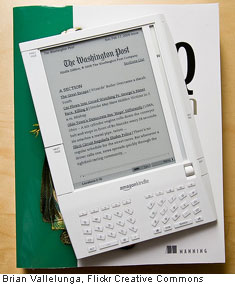 |
| Well, look what’s on the screen of this new, handheld Kindle electronic reader: a newspaper page! |
There is one other vision of newspapers’ future, advanced by none other than the sprawling Hearst media conglomerate, which just closed Seattle’s printed Post-Intelligencer. It has developed an electronic reader that’s much larger than Amazon.com’s popular new Kindle, which is designed primarily for books . I haven’t seen Hearst’s new reader, but I picture a sort of floppy X-ray-sized sheet of film where one can see an entire newspaper page and electronically zip through the entire “paper.” Of course I’d be terrified to set my hot coffee cup on it or let the cats anywhere near it. And how would I tear out an article to bring to work?!
Let’s see if I can summarize all that’s been happening and what it means for the future of daily newspapers. I’ll simply repeat a few phrases from this very posting. They won’t be pretty:
 |
| Discarded. Will this soon be the word not just for this one paper but for newspapers in general? |
“Shut down its presses.” “Closed its doors.” “Indebtedness.” “Bankruptcy protection.” “News – none of it good.” “Furlough without pay.” “Money-losing newspaper.” “Folding of entire sections.” “Terrible bleeding.” “Readership and advertising nosediving.” “Shrinking generation of readers.” “Hopelessly behind.” “Unconnected to their times.” “She can find what she wants online.” “News organizations are merrily giving away the news.” “Financial strangulation and a slow death.”
And if I may be forgiven one more gasp of horror about the last one:
“News may soon be delivered by video game.”
It all makes you wonder what they’re telling college print-journalism majors. If there are any, any more.
(These are a few of the words from this posting that you may not know. Each time, I’ll tell you a little about them and also place them into a cumulative archive of “Ted’s Wild Words” in the right-hand column of the home page. Just click on it there, and if there’s another word in today’s blog that you’d like me to explain, just ask!)
Circumspectly. Cautiously, watchfully, often a little furtively, not wanting to call attention to oneself.
Cumbersome. Awkward, unwieldy, hard to manipulate physically.
Genie. In popular fable, a genie is a powerful, often turban-wearing figure imprisoned in a bottle. Some lucky soul stumbles upon the bottle, rubs it, frees the delighted genie, and is granted one or more fabulous wishes. The origin of the word is less cheerful, however. In early African and Middle East cultures, genies were sinister spirits that took animal or human form.
Morose. Gloomy, sullen, dejected.
Ponzi scheme. An age-old grifter’s con in which investors are convinced to send the schemer considerable sums of money on the promise of lavish returns. Handsome interest is indeed paid, using some of the money contributed by fresh, eager new investors. But the crook is keeping most of it. Ponzi schemes almost always collapse when not enough new investors can be found, or old ones are tipped off to trouble and try to pull out their money en masse. They quickly find that there’s no money at all.
Town Crier. In a tradition brought from Europe, criers, employed by the community, would walk the streets of early America, often at dusk, carrying lanterns or handbells, calling out public announcements. These would often begin, “Hear ye, hear ye,” or the more formal “oyez,” which is still used to bring many U.S. courtrooms to order.








